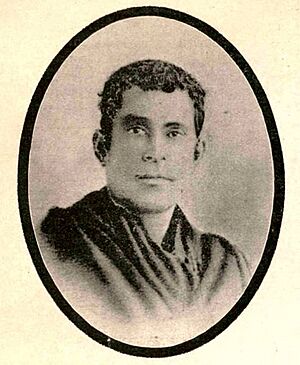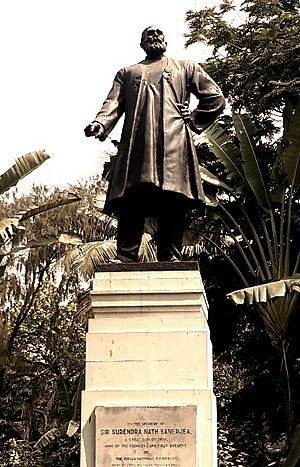Surendranath Banerjee facts for kids
Quick facts for kids
Rashtraguru, Sir
Surendranath Banerjee
|
|
|---|---|

S. N. Banerjee
|
|
| 11th President of the Indian National Congress | |
| In office 1895–1896 |
|
| Preceded by | Alfred Webb |
| Succeeded by | Rahimtulla M. Sayani |
| Succeeded by | Lalmohan Ghosh |
| Personal details | |
| Born | 10 November 1848 Calcutta, Bengal Presidency, British India (present-day Kolkata, West Bengal, India) |
| Died | 6 August 1925 (aged 76) Barrackpore, Bengal Presidency, British India (present-day West Bengal, India) |
| Citizenship | British Raj |
| Political party | Indian National Congress (1883–1919) Indian National Liberation Federation (1919–1925) |
| Alma mater | |
| Occupation | Academician • politician • |
| Known for | Founder of Indian Liberation Federation, Indian National Association, Co-founder of Indian National Congress |
Sir Surendranath Banerjee (Bengali: সুরেন্দ্রনাথ বন্দ্যোপাধ্যায়; 10 November 1848 – 6 August 1925) was a very important Indian leader during the time of British Rule. People often called him Rashtraguru, which means 'Teacher of the Nation'.
He started a group called the Indian National Association. Its goal was to bring Hindus and Muslims together to work for political change. He was also one of the people who helped create the Indian National Congress. Later, Surendranath supported some new rules called the Montagu–Chelmsford Reforms. Because of this, he left the Congress party with other leaders and started a new group in 1919 called the Indian National Liberation Federation.
Contents
Early Life and Education
Surendranath Banerjee was born in Calcutta, in a region called Bengal. His family was from a special group called Rarhi Kulin Brahmin. His father, Durga Charan Banerjee, was a doctor who taught him to think in a modern and open-minded way.
After finishing college at the University of Calcutta, Surendranath went to England in 1868. He wanted to take a test to join the Indian Civil Service, which was a very important job. He passed the test in 1869, but there was a problem with his age. He explained that he calculated his age differently, based on Hindu customs. After sorting it out, he passed the test again in 1871.
He then worked as an assistant magistrate in a place called Sylhet. While in England, he also took classes at University College, London. He finished his studies and came back to India in August 1871. In 1874, he went back to London to study law.
Facing Challenges Abroad
Surendranath was later removed from his job because of a mistake he made. He went back to England to try and get his job back, but he was not successful. He felt this was due to unfair treatment because he was Indian. This experience made him feel disappointed with the British.
During his time in England (1874–1875), he read books by thinkers like Edmund Burke. These ideas helped him in his protests against the British. People even called him the 'Indian Burke'. He was also known as 'Surrender Not Banerjee' by the British because he was so determined. He was also inspired by the writings of an Italian nationalist named Giuseppe Mazzini.
Political Journey
When Surendranath returned to India in June 1875, he became an English professor. He taught at several colleges, including the Rippon College, which he founded in 1882. He inspired his students with new ideas about Indian nationalism.
He started giving public speeches about politics and Indian history. On July 26, 1876, he founded the Indian National Association with Anandamohan Bose. This was one of the first political groups in India. He wanted to bring all people together, saying, "Let the word 'Unity' be inscribed therein characters of glittering gold."
He used this group to fight against unfair rules, like the age limit for Indian students taking the Civil Service exams. He spoke out against unfair treatment by British officials across the country, which made him very popular.
Leading the Way with The Bengalee
In 1879, he bought a newspaper called The Bengalee and worked as its editor for 40 years. In 1883, Surendranath faced legal trouble for something he published in his newspaper. When he was arrested, protests and strikes happened all over Bengal and in other Indian cities. He was the first Indian journalist to be put in prison.
After the Indian National Congress was formed in 1885, Banerjee joined his group with it in 1886. This was because they shared similar goals. He was chosen to be the Congress President twice, in 1895 and 1902.
Surendranath was a key leader who spoke out against the plan to divide the Bengal province in 1905. He led protests and gathered public support across India. This pressure eventually made the British change their decision in 1912.
He also supported younger Indian leaders like Gopal Krishna Gokhale and Sarojini Naidu. Banerjee was a leader of the 'moderate' group in Congress. These leaders preferred to talk and work with the British. He was also important in the Swadeshi movement, which encouraged people to use goods made in India instead of foreign products. His popularity was so high that some called him the "uncrowned king" of Bengal.
Later Years and Legacy
As time went on, the popularity of moderate Indian politicians like Banerjee decreased. He supported the Morley-Minto reforms 1909, but many Indians felt these changes were not enough.
Even though he disagreed with Mahatma Gandhi's method of civil disobedience, he admired Gandhi's efforts to unite Hindus and Muslims. Surendranath Banerjee and other moderate leaders left the Congress party because they wanted to accept the Montagu-Chelmsford Reforms. They formed the Indian Liberation Federation. However, they lost some of their influence in the Indian independence movement.
He became a minister in the Bengal government, which made some nationalists unhappy. He lost an election in 1923, which largely ended his political career. He was given the title of 'knight' by the British for his support. While serving as a minister, he helped make the Calcutta Municipal Corporation more democratic.
Surendranath Banerjee is remembered as a pioneer leader in Indian politics. He was one of the first to pave the way for Indians to gain more political power. He wrote a famous book called A Nation in Making, which was published in 1925. Surendranath Banerjee passed away in Barrackpore on August 6, 1925.
Commemoration
Many places are named after Surendranath Banerjee to honor him. These include:
- Barrackpore Rastraguru Surendranath College
- Raiganj Surendranath Mahavidyalaya
- Surendranath College
- Surendranath College for Women
- Surendranath Evening College
- Surendranath Law College (which used to be called Ripon College)
- The Surendranath Centenary School in Ranchi
- Surendranath Banerjee Road (also known as S. N. Banerjee Road)




